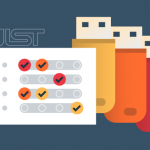
USB flash drives have been the root cause of some of the biggest data breaches of the last twenty years. USBs are not only easy to lose, forget, and steal due to their size but have become a widespread malware infection tool as well. Cybercriminals can also bypass login credentials and access unencrypted hard drives by booting up computers using USBs. Consequently, a comprehensive cybersecurity strategy must also include tools that control the use of USB ports. This is what USB Blocker exactly does.
As its name suggests, USB Blocker allows companies to block the use of USB and peripheral ports on work computers. While this seems like an easy fix for the risks posed by removable devices such as USBs and external drives, employees may feel differently about it. If the elimination of the use of USB ports disrupts existing workflows and hinders employees in their day-to-day tasks, they might search for alternative file transfer methods online. This opens sensitive data up to a whole new category of security threats. While Data Loss Prevention (DLP) tools like Endpoint Protector can be used to mitigate them, companies can also use USB Blocker to limit rather than block the use of USB ports completely.
While using USB Blocker, companies can assign different levels of trust to devices connecting via USB ports based on their level of encryption. In this way, only devices with a high level of security are allowed to connect to endpoints. Alternatively, company-issued devices can also be whitelisted in a USB Blocker. There is also the possibility of enabling a read-only setting that allows users to read files on devices connected via USB ports but blocks file transfers to and from them.
Granular USB control policies
One rule rarely fits all. The bigger a company is, the more complex the needs of its various departments and employees. Having granular data protection policies in place is a crucial requirement to minimize the impact on employee productivity. USB blocker allows companies to set USB port control policies based on particular groups, users, departments, or computers.
In this way, organizations can, for example, enforce stricter policies for groups that work directly with sensitive data regularly while allowing greater freedom to the rest of their workforce. The opposite approach can also be applied: a company-wide block of the use of USB ports with exceptions made for particular users or departments that need to use removable devices for data transfers regularly.
USB port control outside of the office
Businesses are often confident in the cybersecurity measures applied at a company network level; they may feel that removable devices do not need to be restricted when working in the office. However, with the rise of remote work and hybrid work environments, businesses can no longer ignore the very real problem of data security while working from home.
USB blocker allows companies to set different policies for when an employee is in or outside the office. They can enforce stricter USB port control policies outside office hours, the company network, or both. By defining working days and hours as well as a company network’s DNS and ID, they can set different rules based on when and where an employee is working.
Monitoring USB port use
Another valuable feature of USB Blocker is that it blocks or limits USB port usage and tracks their use. This means that companies can be aware at all times which employee has attempted to use removable devices, which devices they connected to a work computer, what files they tried to transfer, and when. These logs and reports can help companies identify potential malicious insiders attempting to steal data, but also bad practices among employees that may need to be addressed through training.
Flexibility in exceptional cases
Sometimes the unexpected happens. An employee who generally does not use removable devices and has their USB ports blocked may suddenly need to use a device in an exceptional situation. USB Blocker allows admins to easily and efficiently block and unblock USB ports. In this way, a USB port can be unblocked for a limited time and then immediately blocked again without going through any cumbersome procedures.
Cross-platform USB port control
Nowadays, most companies run multi-OS environments. Removable devices are a security concern regardless of the operating system a computer is running on, as most endpoints come with USB and peripheral ports. As such, companies should invest in cross-platform USB port control solutions. USB Blocker allows organizations to set policies for Windows, macOS, and Linux computers from a single web-based interface, making USB port control efficient but also offering the same features for all operating systems.
Download our free ebook on
Data Loss Prevention Best Practices
Helping IT Managers, IT Administrators and data security staff understand the concept and purpose of DLP and how to easily implement it.













